
Studia Universitatis Babes-Bolyai Chemia
Scope & Guideline
Bridging Knowledge Gaps in Chemical Research
Introduction
Aims and Scopes
- Theoretical and Computational Chemistry:
Focuses on the application of theoretical models and computational methods, such as density functional theory (DFT), to understand chemical interactions and phenomena. - Materials Chemistry and Nanotechnology:
Explores the synthesis, characterization, and application of novel materials, including nanomaterials, with a particular emphasis on their physical and chemical properties. - Environmental Chemistry and Sustainability:
Investigates the chemical processes affecting the environment, including waste management, pollution control, and the development of sustainable practices and materials. - Biochemistry and Chemical Biology:
Examines the chemical processes within and related to living organisms, focusing on the development of bioactive compounds and their applications in medicine and agriculture. - Analytical Chemistry:
Covers advancements in analytical techniques and methodologies for the qualitative and quantitative analysis of chemical substances, including the application of chromatography and mass spectrometry.
Trending and Emerging
- Green Chemistry and Sustainable Practices:
There is an increasing emphasis on environmentally friendly practices, such as the development of biodegradable materials and the use of renewable resources in chemical processes. - Nanotechnology and Advanced Materials:
Research related to nanomaterials and their applications across various fields, including medicine and environmental science, has surged, reflecting the importance of nanotechnology in modern chemistry. - Bioactive Compounds and Natural Products:
A notable trend is the exploration of bioactive compounds derived from natural sources, focusing on their potential therapeutic applications and health benefits. - Electrochemical Methods:
The utilization of electrochemical techniques for chemical analysis and synthesis is gaining popularity, particularly in the context of energy storage and conversion technologies. - Interdisciplinary Approaches:
There is a growing trend towards interdisciplinary research that combines chemistry with biology, materials science, and environmental studies to address complex scientific problems.
Declining or Waning
- Classical Organic Synthesis:
Research focused on traditional organic synthesis methods has decreased, possibly due to a growing emphasis on green chemistry and more sustainable synthesis techniques. - Conventional Analytical Techniques:
There appears to be a waning interest in classical analytical methods, with a shift towards more sophisticated and innovative techniques like high-performance liquid chromatography (HPLC) and mass spectrometry. - Inorganic Chemistry Applications:
The application of inorganic chemistry principles in industrial contexts has seen less frequent publication, perhaps due to a growing focus on interdisciplinary approaches that combine various fields of chemistry.
Similar Journals

Orbital-The Electronic Journal of Chemistry
Transforming Research into Accessible KnowledgeOrbital - The Electronic Journal of Chemistry, ISSN 1984-6428, is an esteemed open-access journal published by the Universidade Federal de Mato Grosso do Sul, Department of Chemistry, since 2009. Located in the vibrant academic landscape of Campo Grande, Brazil, this journal aims to bridge the gap between research and practice in the fields of Chemistry, Chemical Engineering, and Materials Science. Despite its current categorization in the Q4 quartile ranks, Orbital plays a pivotal role by providing a platform for innovative ideas, emerging technologies, and interdisciplinary research that advances the understanding of chemical processes and materials. With its commitment to open access, the journal ensures that research findings are readily available to a global audience, promoting collaboration and knowledge dissemination among researchers, professionals, and students alike. Readers can expect a diverse range of articles, from foundational chemistry studies to cutting-edge developments in materials science, reflecting the journal’s dynamic scope and contribution to the scientific community.
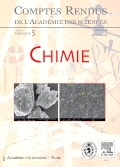
COMPTES RENDUS CHIMIE
Exploring New Frontiers in Chemistry and Engineering.COMPTES RENDUS CHIMIE, published by the prestigious Académie des Sciences in France, stands as a significant journal in the fields of chemistry and chemical engineering. With an ISSN of 1631-0748 and an E-ISSN of 1878-1543, this open-access journal has been committed to disseminating high-quality research since its transition to open access in 2020. Featuring a diverse array of studies, the journal covers innovative research trends and applications, while maintaining a Q3 category ranking in both Chemical Engineering (miscellaneous) and Chemistry (miscellaneous) as of 2023. Its Scopus rankings, positioning at #251 out of 408 in general chemistry and #169 out of 273 in general chemical engineering, highlight its growing impact within the scientific community. Authored by a global cohort of scientists and researchers, COMPTES RENDUS CHIMIE is dedicated to the advancement of knowledge and sharing insights that are vital for ongoing research and development in the chemical sciences. Located in the heart of Paris at 23 Quai de Conti, 75006, France, the journal is an essential resource for those passionate about chemistry and engineering disciplines, fostering collaboration and innovation across the world.
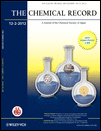
CHEMICAL RECORD
Bridging Gaps with Cutting-Edge Chemical ResearchThe Chemical Record is a prestigious peer-reviewed journal published by WILEY-V C H VERLAG GMBH, focusing on innovative research and developments across the diverse and evolving fields of chemistry and biochemistry. With an esteemed 2023 Impact Factor and recognized as a Q1 journal in several categories—including Biochemistry, Chemical Engineering, and Materials Chemistry—The Chemical Record stands as a critical resource for researchers, professionals, and students aiming to disseminate and acquire knowledge in these disciplines. The journal's engaging scope covers contemporary topics and fosters collaboration within the global scientific community, ensuring accessibility to cutting-edge research. By publishing articles that meet the highest standards of scholarship, it has earned a significant place within the academic ecosystem, as reflected in its strong Scopus rankings. Although The Chemical Record operates without open access, it remains deeply committed to advancing the field of chemistry through rigorous and impactful publications that bridge gaps between theory and practice.
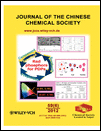
JOURNAL OF THE CHINESE CHEMICAL SOCIETY
Advancing Chemistry Through Innovative ResearchJOURNAL OF THE CHINESE CHEMICAL SOCIETY, published by WILEY-V C H VERLAG GMBH, is a vital resource in the field of chemistry, focusing on a broad array of topics pertinent to general chemistry and its advancing sub-disciplines. Established in 1954 and running through 2024, this journal serves as a significant platform for the dissemination of high-quality research, showcasing innovative findings and developments within the chemical sciences. With its Q3 category ranking and positioning at Rank #203 in General Chemistry per Scopus, it reflects the journal's commitment to research excellence and impact. While not an open-access publication, it ensures accessibility to a global audience, making it an essential tool for researchers, professionals, and students alike seeking to stay informed and engaged in the evolving landscape of chemistry.

Canadian Journal of Chemistry
Fostering Interdisciplinary Discoveries in ChemistryWelcome to the Canadian Journal of Chemistry, a prominent publication dedicated to advancing the study of chemistry through original research and critical reviews. Published by Canadian Science Publishing, this journal has been a cornerstone of chemical research since its inception, covering a broad spectrum of topics within the field, including catalysis, organic chemistry, and general chemistry. With an ISSN of 0008-4042 and E-ISSN of 1480-3291, it provides a vital platform for researchers, professionals, and students to disseminate their findings and engage in scholarly discourse. Impact Factor is currently in development, with the journal classified in the Q4 category for catalysis and Q3 for miscellaneous chemistry fields, signifying its evolving contributions to the scientific community. The journal operates without an open access model, which ensures a rigorous peer-review process while maintaining subscription access for institutions and libraries. Located in Ottawa, Canada, the Canadian Journal of Chemistry continues to provide an invaluable resource for those dedicated to the scientific pursuit of chemistry, making significant strides in fostering interdisciplinary approaches and innovative research methodologies.

Moscow University Chemistry Bulletin
Fostering Collaboration and Knowledge in ChemistryMoscow University Chemistry Bulletin is a distinguished academic journal dedicated to advancing the field of chemistry, published by PLEIADES PUBLISHING INC. With an ISSN of 0027-1314 and an E-ISSN of 1935-0260, this journal provides a platform for researchers, professionals, and students to explore a wide range of topics in general and specialized chemistry. While it holds a current Q4 ranking in the “Chemistry (miscellaneous)” category according to Scopus, the journal is committed to broadening its scope and visibility, aiming for greater impact in the global scientific community. Moscow University Chemistry Bulletin focuses on the publication of cutting-edge research, reviews, and discussions that stimulate innovation and collaboration. Although it is not an Open Access journal, it plays a crucial role in disseminating knowledge and fostering academic dialogue within the field, as it converges towards significant findings from 2004 to 2024. The continuous development of its content holds the potential to attract a diverse readership, making it a valuable resource for those involved in the chemical sciences.

Journal of the Iranian Chemical Society
Pioneering Discoveries in the Heart of ChemistryThe Journal of the Iranian Chemical Society, published by SPRINGER, is a prominent academic journal dedicated to advancing the field of chemistry. With an ISSN of 1735-207X and an E-ISSN of 1735-2428, this quarterly journal has been contributing valuable research from 2006 to 2024. Situated in Germany, it serves as a vital platform for chemists and researchers to disseminate their findings, particularly within the miscellaneous chemistry category, where it ranks in the Q3 quartile for 2023. Despite its current lack of open access options, the journal maintains a solid presence in the academic community, evidenced by its Scopus ranking of #165 out of 408 in general chemistry and a commendable 59th percentile. The journal's objective aims to foster innovation and collaboration in chemical research, making it an essential resource for professionals and students keen on pioneering developments in the field. As a subscriber, you will gain insights into cutting-edge research that drives the future of chemistry.
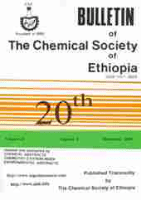
BULLETIN OF THE CHEMICAL SOCIETY OF ETHIOPIA
Driving Knowledge Forward in the World of ChemistryBULLETIN OF THE CHEMICAL SOCIETY OF ETHIOPIA (ISSN: 1011-3924; E-ISSN: 1726-801X), published by the Chemical Society of Ethiopia, serves as a pivotal platform for the dissemination of innovative research and developments within the field of chemistry. Since its inception in 1996 and now an open access journal since 2012, it has provided researchers, academics, and students with unrestricted access to critical studies and findings, thus fostering collaboration and the advancement of knowledge in the discipline. The journal's current standing in the Q3 quartile in the 2023 Chemistry category underlines its commitment to maintaining high academic standards, while its Scopus ranking, positioned at #250 out of 408 in general chemistry, showcases its growing influence and contribution to the scientific community. Hailing from Ethiopia and targeted toward a global readership, the journal aims to highlight local and international research, engaging scholars and practitioners alike in discussions that propel the science of chemistry forward.
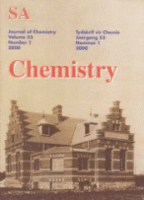
SOUTH AFRICAN JOURNAL OF CHEMISTRY-SUID-AFRIKAANSE TYDSKRIF VIR CHEMIE
Advancing Chemistry Through Open Access InnovationSouth African Journal of Chemistry (Suid-Afrikaanse Tydskrif vir Chemie), published by Bureau Scientific Publications, is a pivotal open-access journal that has been disseminating groundbreaking research in the field of chemistry since its inception in 1996. With an ISSN of 0379-4350 and an E-ISSN of 1996-840X, this journal serves as a vital platform for researchers and professionals seeking to share their work and engage with the global chemistry community. Recognized for its significant contributions, the journal holds a Q3 quartile ranking in the miscellaneous chemistry category as of 2023 and ranks #216 out of 408 in General Chemistry according to Scopus. The South African Journal of Chemistry is dedicated to advancing knowledge in the discipline by publishing a wide array of articles, reviews, and studies that address pertinent chemical research and applications. With open access options available since 2000, it fosters a collaborative environment, ensuring that research is accessible to all, thereby enhancing the visibility and impact of chemists' work across South Africa and beyond.

Hemijska Industrija
Innovating Chemistry: Bridging Research and ApplicationHemijska Industrija, an esteemed journal published by the Association of Chemical Engineers of Serbia, serves as a critical platform for advancing knowledge in the fields of chemical engineering and chemistry since its inception in 1989. With an Open Access policy adopted in 2017, the journal provides global access to cutting-edge research and innovative findings, enhancing visibility for authors and fostering collaboration among researchers, professionals, and students alike. This peer-reviewed journal currently holds a Q3 ranking in both Chemical Engineering (miscellaneous) and Chemistry (miscellaneous) categories, signifying its growing impact in these fields. Published in Belgrade, Serbia, Hemijska Industrija not only disseminates high-quality articles from various disciplines within chemical science but also emphasizes interdisciplinary approaches and practical applications, making it an invaluable resource for anyone seeking to stay at the forefront of chemical innovations.